Affiliate links on Android Authority may earn us a commission. Learn more.
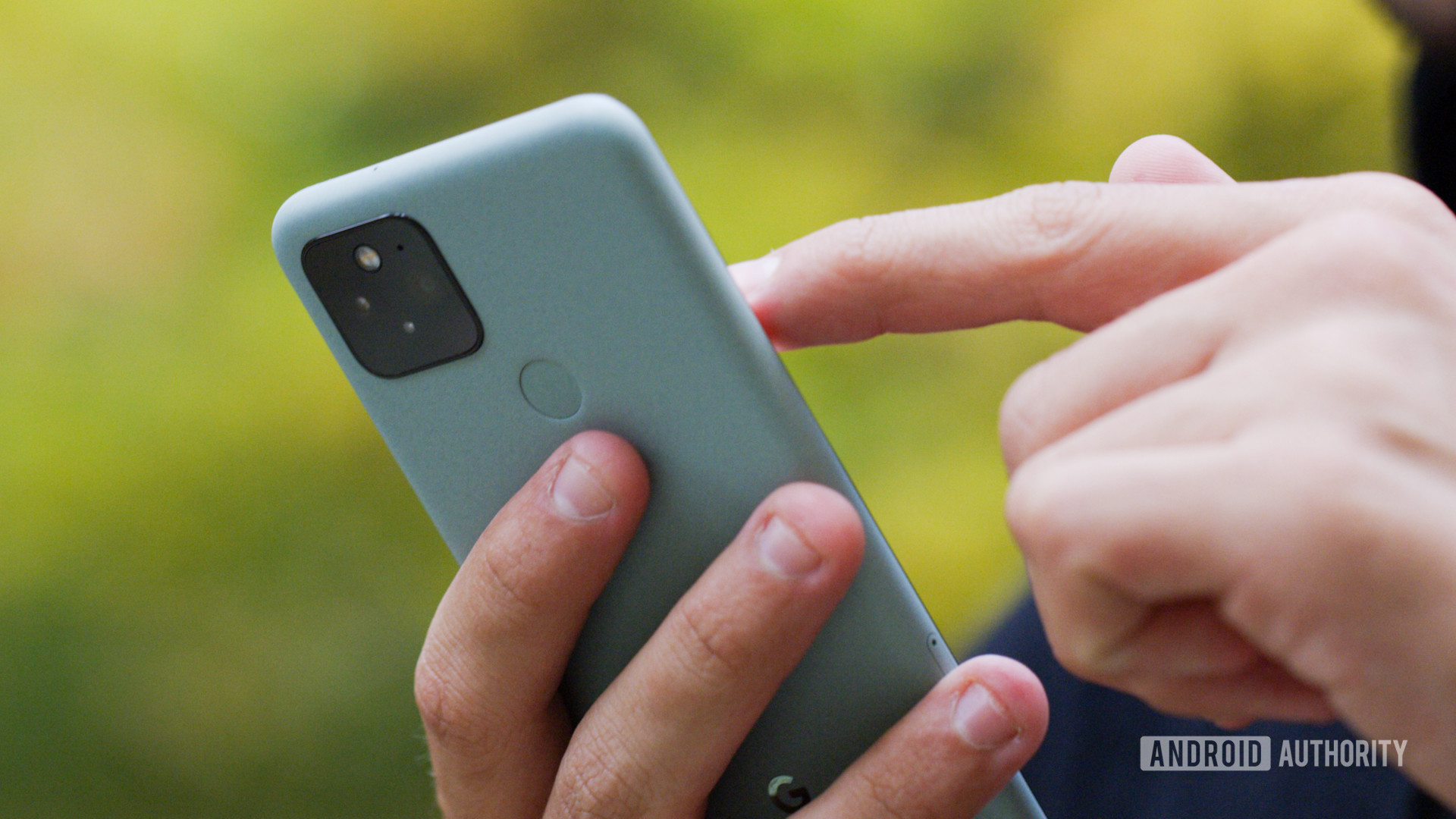


Google Pixel 5
What we like
What we don't like
Our scores

Google Pixel 5
The Google Pixel has been a premium product since its inception in 2016. Google wanted the series to rival the iPhone. That is, to have such a tight integration between software and hardware that the experience wasn’t just usable, it was delightful. Until now, however, the company has demanded a premium price to make this happen, but the fact is, Google just doesn’t yet have the die-hard fan base that Apple does. Because of this, Google has had a hard time moving units over the years.
This generation, the Mountain View company is taking a different approach. Google is a software company first, and while it still wants the Pixel 5 to be its flagship smartphone, it’s cut some corners to bring the price down to a more affordable level. While 2019’s Pixel 4 started at $800, the Pixel 5 launched at just $700.
Was the move worth it? Find out in our Google Pixel 5 review.
Update, November 2021: Added details about the latest competition, Android 12, and updated our verdict.
Design and display: Refining the basics
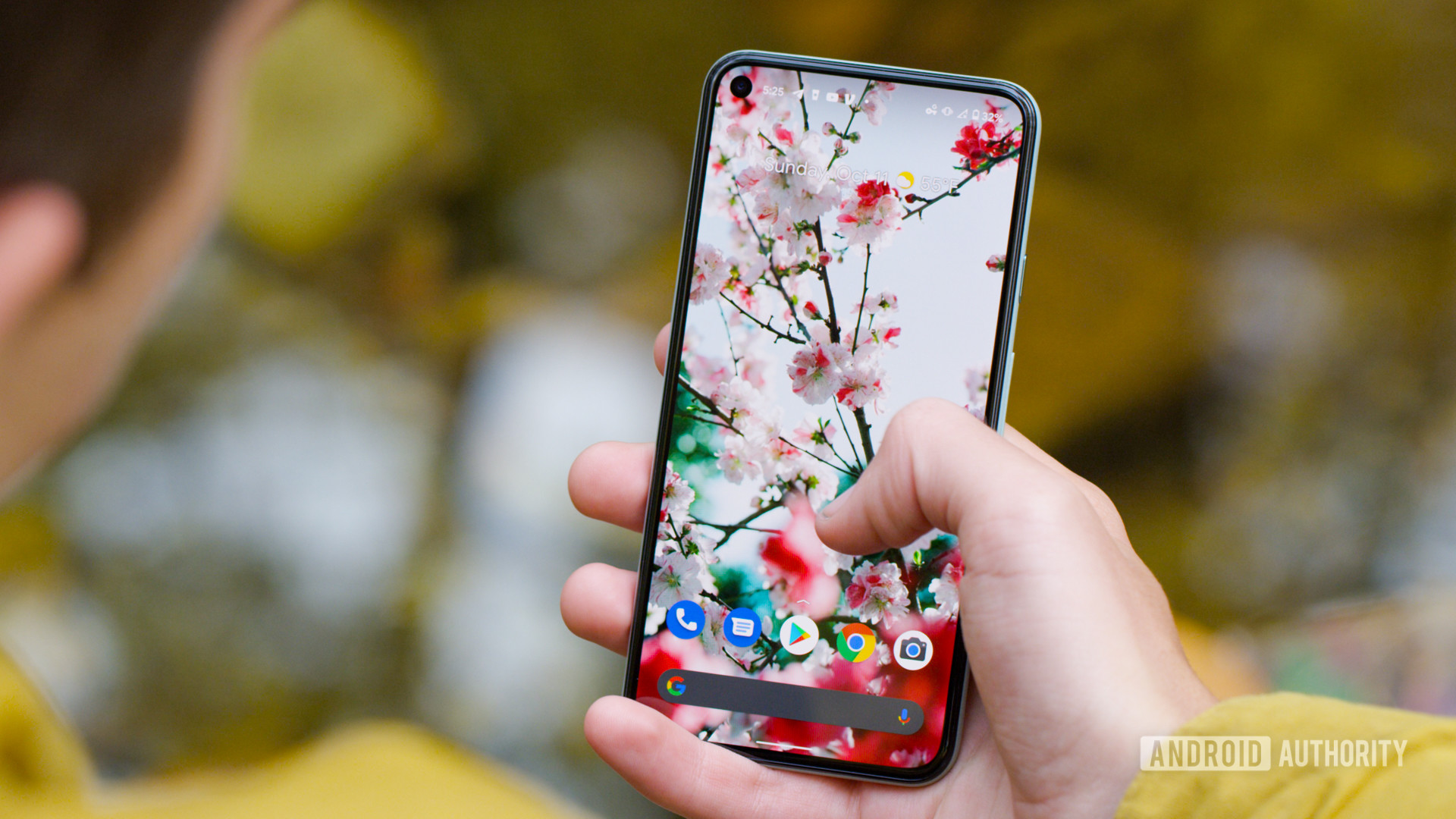
- 144.7 x 70.4 x 8.0mm, 151g
- Rear-mounted fingerprint sensor
- Chrome power button
- Aluminum and bio-resin design
- IP68 water and dust resistance
- 6-inch AMOLED (2,340 x 1,080)
- 19.5:9 aspect ratio
- Minimal bezels
- Hole-punch selfie cutout
- 90Hz adaptive refresh rate
When you look at the Google Pixel 5, it is immediately recognizable as a Google phone. It follows the same general design ethos as the Pixel 4a and Pixel 4a 5G and also snags various design elements from 2019’s Pixel 4 series. The rounded design and squircle-shaped camera module have become staples for the Pixel series for two years running. The Chrome “G” logo near the bottom of the phone’s backside should help if you were still having trouble determining the phone’s origin.
With the Pixel 5, Google has brought back the rear-mounted fingerprint scanner, which is a nice case of foresight on Google’s part considering the ongoing pandemic. The bottom of the phone houses a USB-C port and speakers. The right side sports the volume rocker and a chrome power button. These buttons take a bit of force to press and are fairly clicky, but I noticed they don’t feel quite as clicky as the Pixel 4a’s.
The body of the Google Pixel 5 is made of aluminum, with a special “bio-resin” composite (that’s sciencey jargon for plastic) poured on top. This gives it just a little bit more of a gritty feeling than the Pixel 4a, but the speckled look makes me wish it was even more coarse, like that of the sandstone OnePlus One. While the aluminum and bio-resin combo doesn’t feel quite as premium as the glass Pixel 4, it should certainly be more resistant to breaks and cracks, on the rear at least.
The Pixel 5 also sports IP68 water and dust resistance. This is a spec we expect to see in most flagship devices. It’s a relief to not have to worry about using your phone out in the rain. Combined with the aluminum and plastic design, the Pixel 5 should be quite sturdy overall. I’m a fan.
The display of the Pixel 5 is an FHD+ adaptive AMOLED that can achieve a refresh rate of 90Hz. Adaptive means it can dynamically switch between 60Hz and 90Hz depending on what the phone is doing, and it feels great. I’ve been a bit spoiled by the extremely fast 120Hz and 144Hz displays of other flagship devices, but the 90Hz display on the Pixel 5 didn’t bother me one bit.
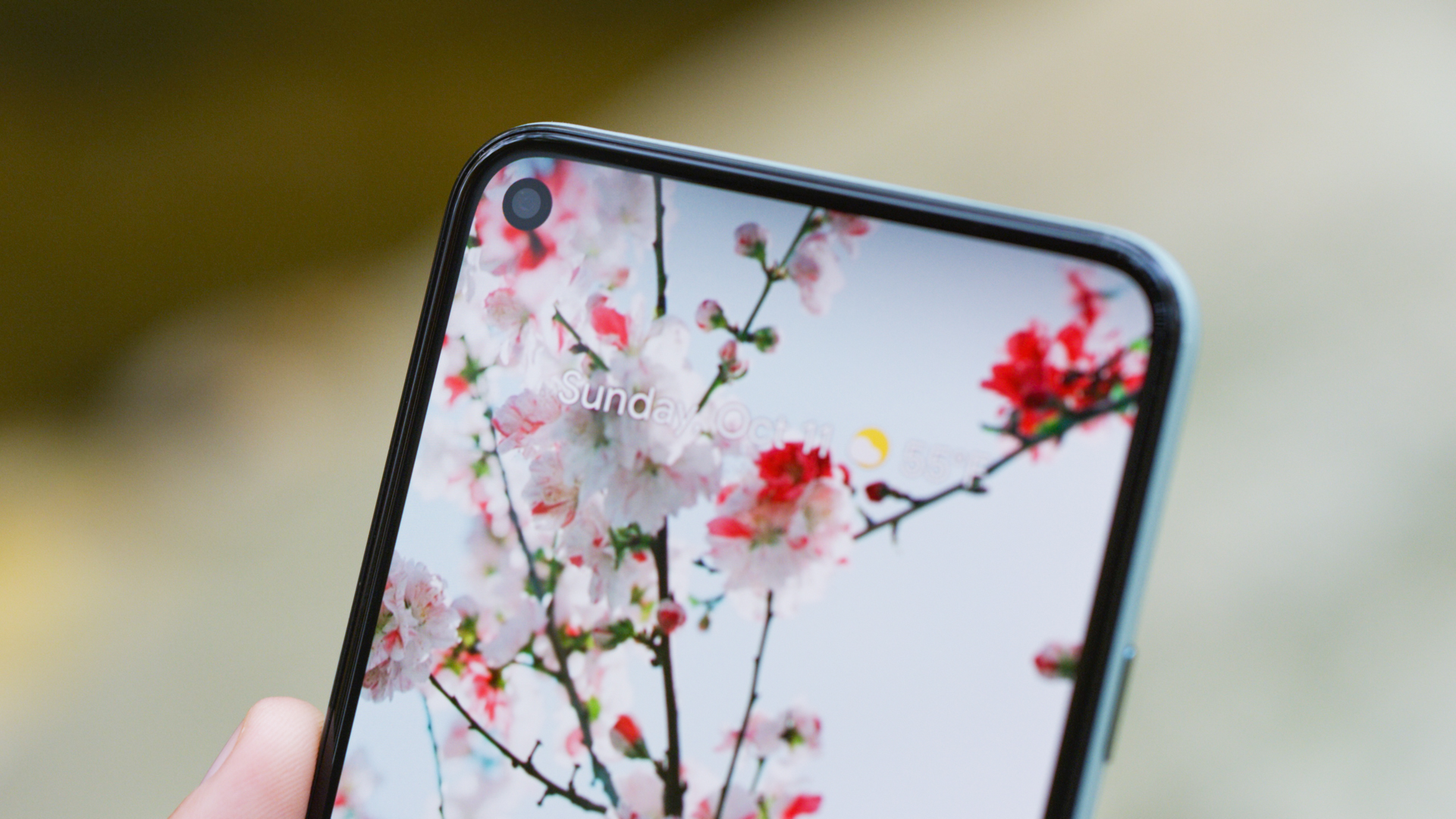
The quality of the Pixel 5’s display is nothing short of fantastic. The colors look incredible and everything seems to pop right off the screen. The display of the Pixel 4a was one of the best we tested in 2020, and there’s no doubt the display of the Pixel 5 touts similar quality. It’s just great.
2020's Pixels have fantastic displays, and the Pixel 5's is especially great.
There is a punch-hole in the top left side of the Pixel 5’s display. It houses the front-facing camera. I’m personally a huge fan of punch-hole selfie shooters because they’re about the same size as a notification icon, so they don’t feel like they’re in the way.
Overall, the Google Pixel 5 doesn’t feel quite as premium as the Pixel 4 before it, but it nails all the design choices that bring a good experience to a phone. While Google undoubtedly went more simplistic with the Pixel 5, I don’t think it needs to be fancy in its designs. Pixels are portals to the quintessential Google experience, and that’s all they really need to be.
Performance and battery: Less is more
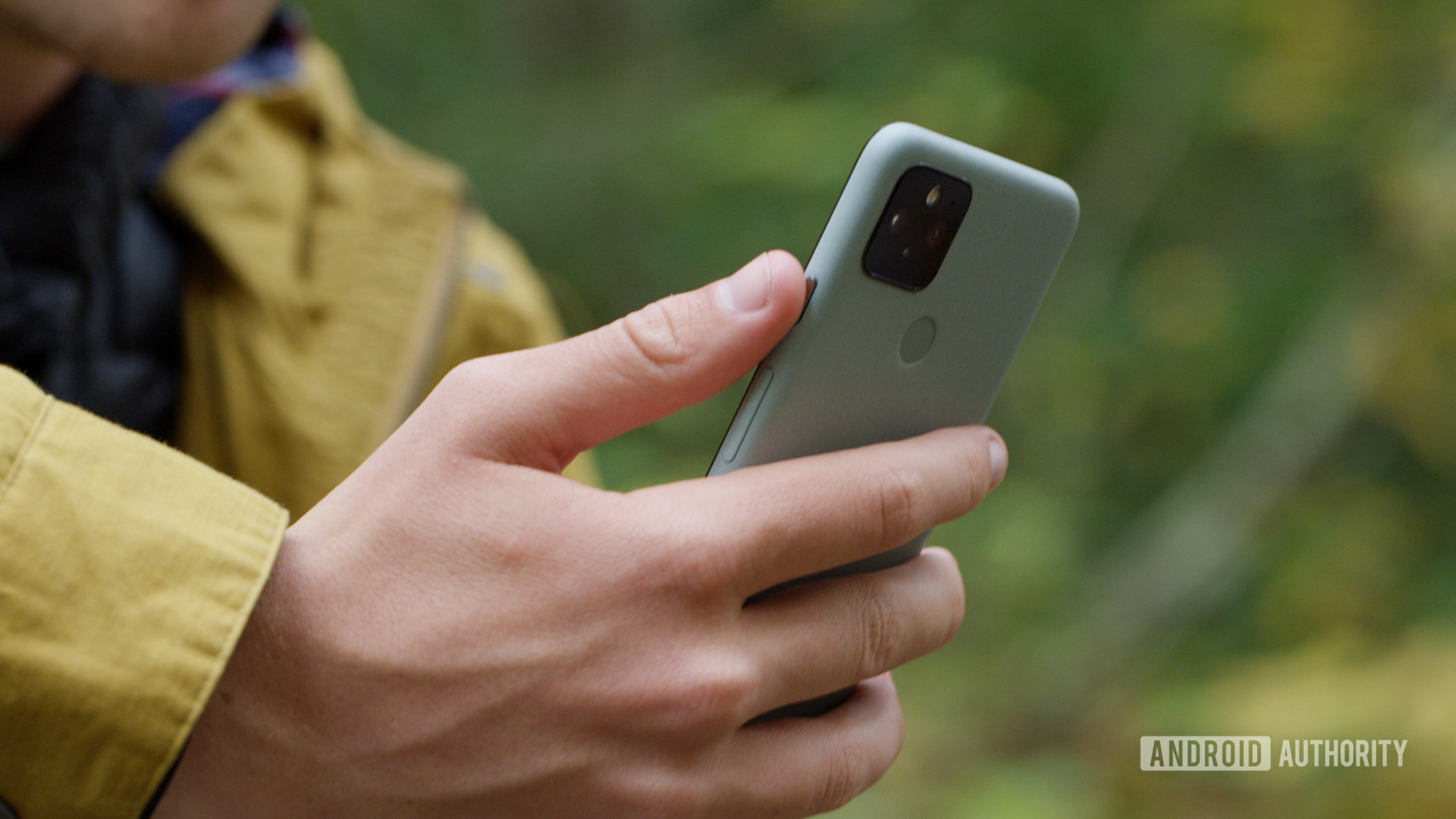
- Qualcomm Snapdragon 765G
- X55 5G mobile platform
- 8GB of RAM
- 128GB of storage
- No microSD card expansion
- 4,080mAh battery
- 18W wired charging
- Wireless and reverse wireless charging
Possibly one of the most controversial decisions Google made with this iteration was not using 2020’s flagship processor from Qualcomm, the Snapdragon 865. Instead, it opted for the tuned-down Snapdragon 765G, which keeps several core features like 5G but cuts down on throughput to the camera as well as core processing speeds.
Many people may be upset that you can’t get a new flagship Pixel that competes with other flagships on a raw performance basis, but I’d wager that Pixels don’t need to be the fastest phones on the market. The whole point of the Pixel experience is a move towards ambient computing. That is, using your phone less and getting the information you need with your voice. Plus, the Pixel UI is so well-tuned to Pixel hardware, you probably won’t notice any slowdowns unless you’re playing the most demanding games the Play Store has to offer.
In everyday use, the Pixel 5 performed adequately. I didn’t notice any performance issues or slowdowns, and the phone jumped between apps with ease. There were no apps kicked from RAM due to the healthy 8GB of memory, while the 90Hz display made everything feel fluid.
In benchmarks, the Google Pixel 5 performed well enough, but it certainly wasn’t the highest score for a Snapdragon 765G device. The Google Pixel 5 notched a score of 2,633 in Geekbench 4 single-core and 5,994 in multi-core. In comparison, the OnePlus Nord scored 2,853 and 7,896 in Geekbench 4 single- and multi-core tests, respectively. Users have reported performance improvements in subsequent updates, particularly for graphics.
One spec that the Snapdragon 765G does hold on to compared to the 865 is 5G connectivity. The Pixel 5 uses the slower Qualcomm X52 modem vs the X55 you’ll find in the flagship variant, but if you’re getting mid-band 5G in your area you could still see a nice boost in speeds. I was hanging with a friend on a rooftop recently and noticed I was pulling 150Mbps down on Google Fi 5G. If you’re on Verizon, the Pixel 5 supports mmWave 5G as well, which can pull down even more insane speeds.
5G probably isn't a game-changer for most people, but it can pull some impressive speeds if you have coverage.
The Pixel 5 sports 128GB of storage, which should be adequate for most people. It is a bit funny that even the $350 Pixel 4a sports the same capacity, but that’s more of a positive for the Pixel 4a than a negative for the Pixel 5. Expandable storage would have been a good way to set the Pixel 5 further apart from the Pixel 4a or Pixel 4a 5G, but Google’s aggressive storage offloading via apps like Google Photos should make this a healthy capacity for most.
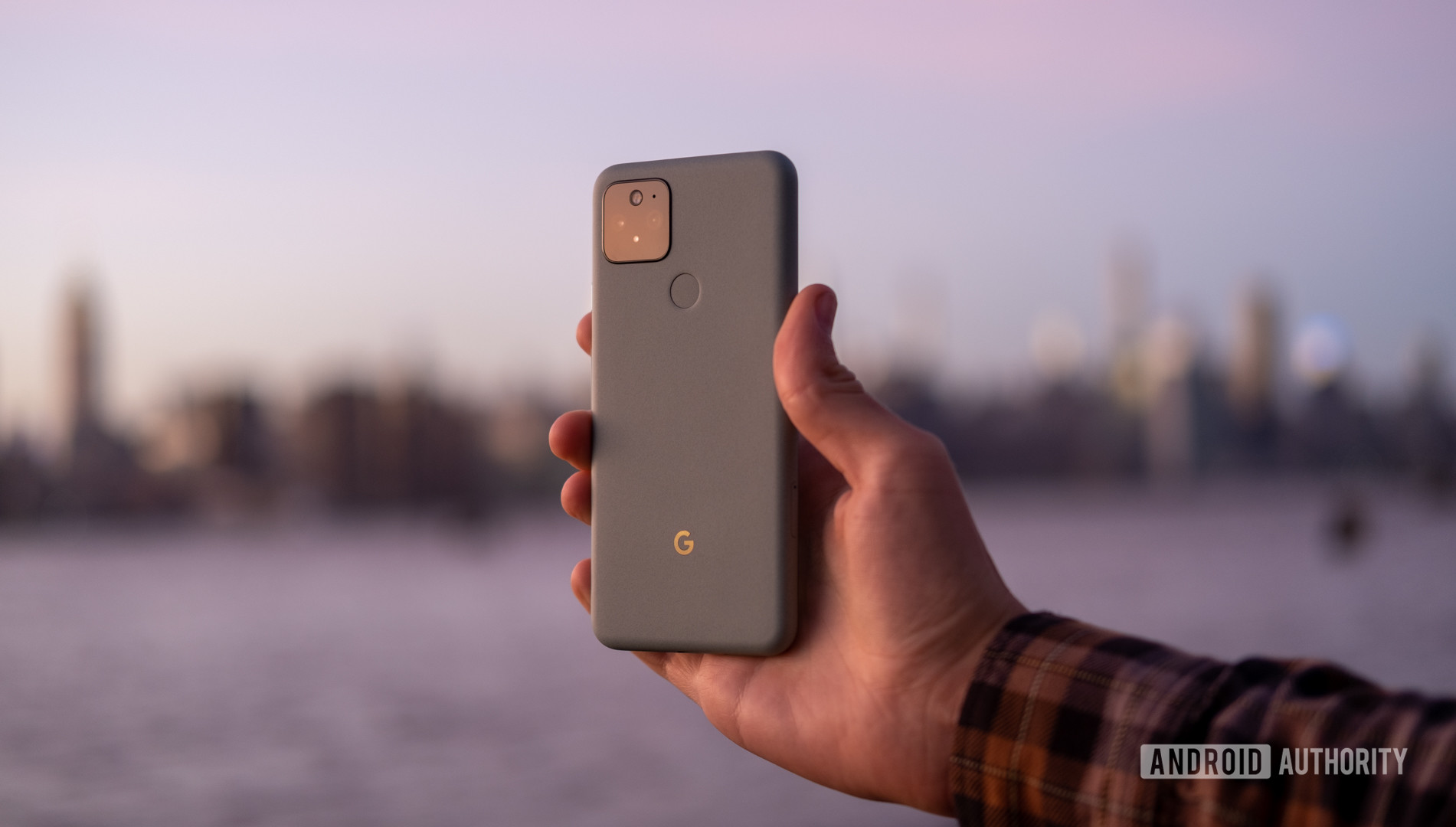
Another pretty massive change in 2020 is the move to a much bigger battery on the Pixel 5. The phone sports a 4,080mAh cell. While that’s not quite as massive as some competing phones, it’s easily the biggest cell ever in a Pixel phone. For comparison, the Pixel 4 sported a 2,800mAh battery and used a more power-hungry processor in the form of the Qualcomm Snapdragon 855. Considering the Pixel 4’s abysmal battery was the weakest point about the phone, the bigger cell is a welcome change.
In daily use, the battery life on the Pixel 5 was quite good. On an average day, the phone lasted nearly eight hours of screen-on time, equating to taking the device off the charger at 8:30 AM and seeing it die around 11 PM the next day. On a heavier day where I shot plenty of 4K video, used almost exclusively mobile data, and didn’t have service for a good portion of the day, the phone pulled closer to six hours of screen-on time. I took it off the charger at 7:30AM that day and it had 10% left when I went to bed at 12:30AM. Not bad.
The Pixel 5 ships with an 18W fast charger. While that’s an acceptable charging speed, it’s starting to feel quite slow compared to its competition. This was fast around the era of the original Pixel, but since then, even mid-ranged devices can hit 30W of charging. I feel like I say this every single time I review a Pixel, but I’d really like to see faster wired charging speeds from Google.
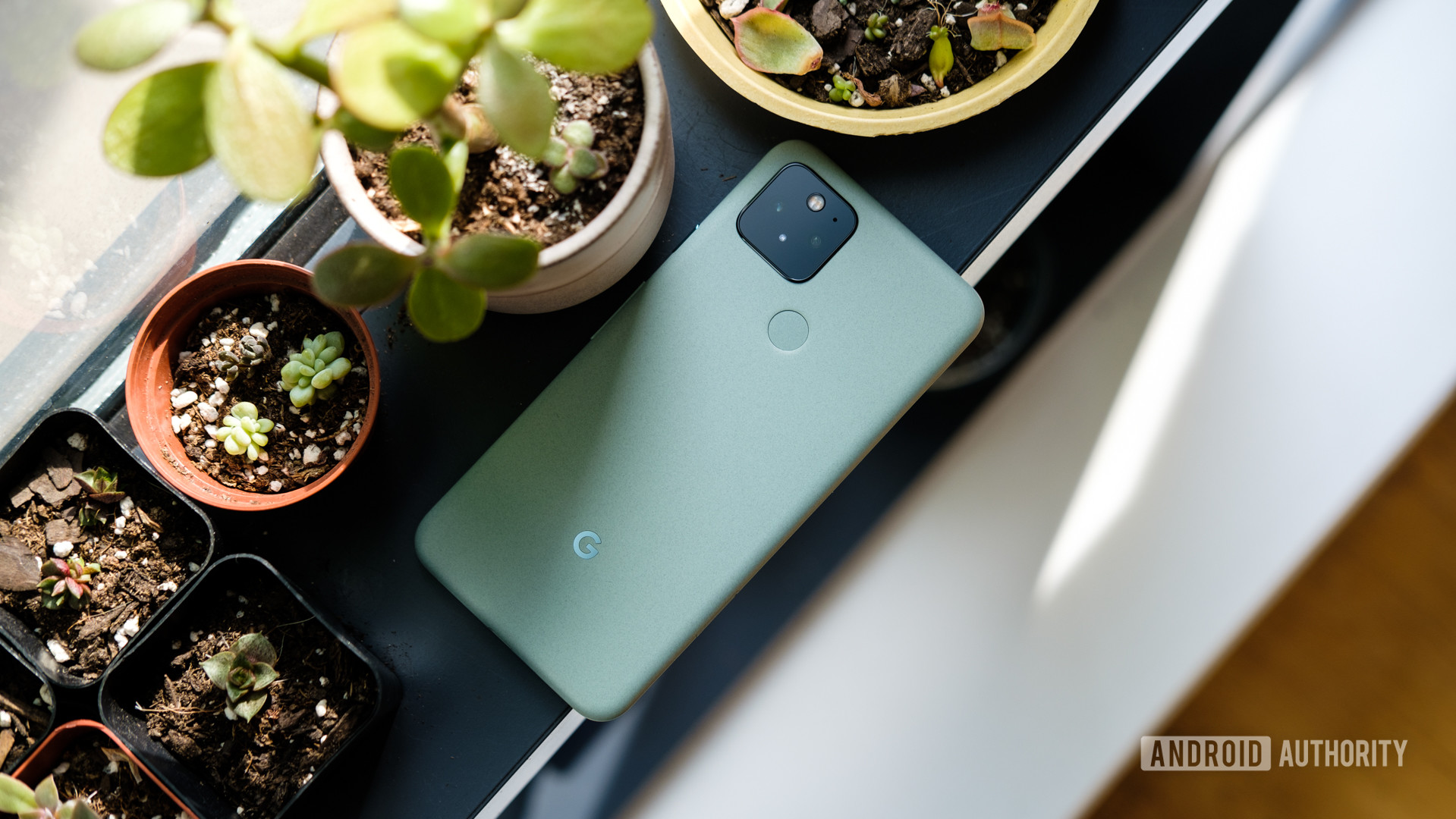
That being said, Google has managed to pack wireless and reverse wireless charging into the Pixel 5. Considering this phone’s chassis is mostly made of aluminum, this is one of the first metal phones to rock wireless charging. To do this, Google cut out a hole in the aluminum chassis for the wireless charging coil, then coated the body in the bio-resin plastic we talked about earlier. Smart stuff.
Wireless charging is a spec that isn’t strictly necessary, but I’m extremely happy to see it on Google’s flagship Pixel. It’s one of those extra little bits that make the Pixel 5 worth choosing over the Pixel 4a or Pixel 4a 5G. Considering I have multiple wireless chargers hanging out around my apartment, it’s easy to keep the phone topped up at all times.
Camera: Wider with better video, otherwise more of the same
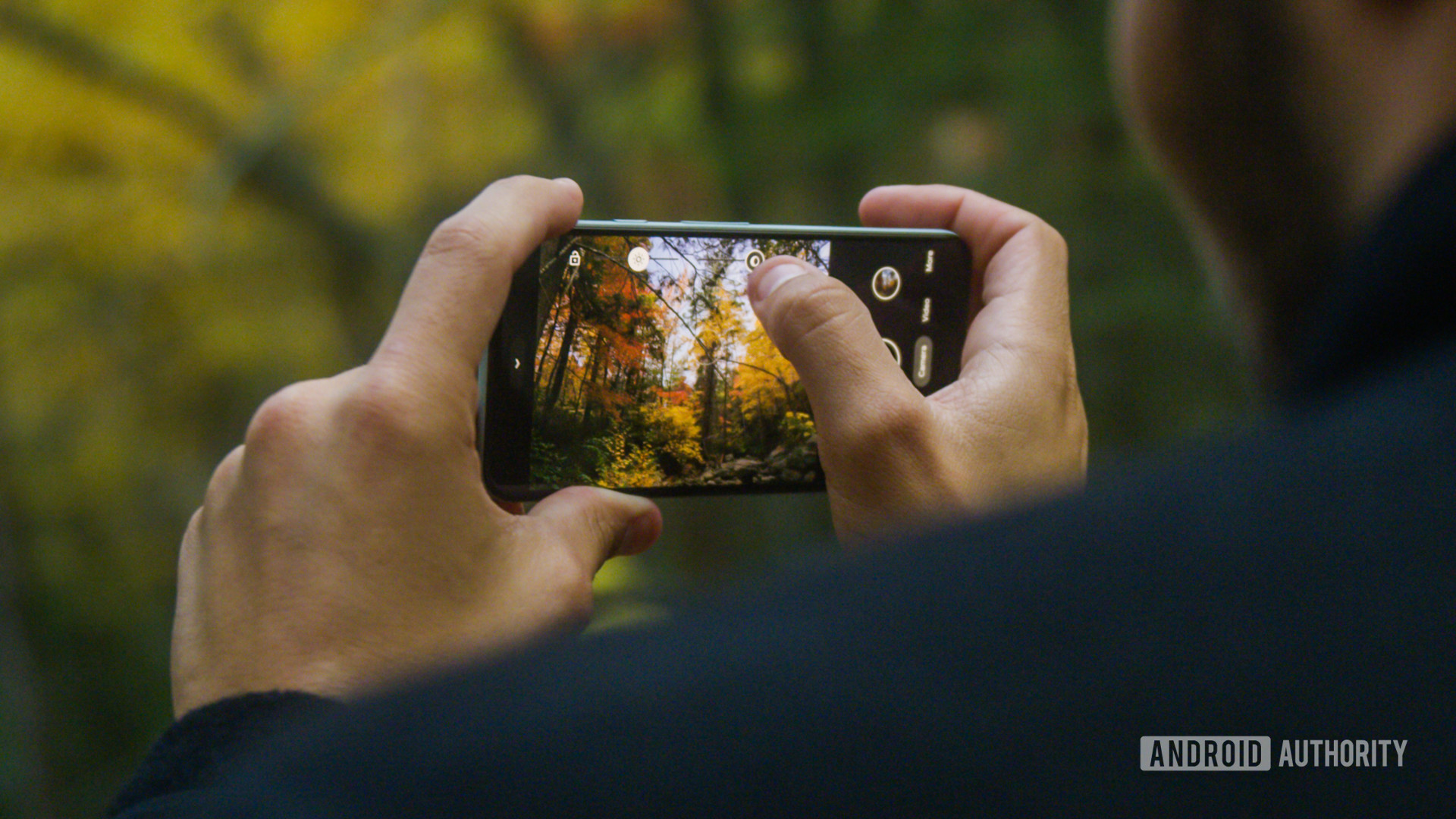
- Main: 12MP
- Wide: 16MP
- Selfie: 8MP
Up until the Pixel 3, Google touted its impressive photo quality from a single camera using computational photography. But by the time the Pixel 4 launched, there was enough pressure from the rest of the industry to add another sensor. Weirdly, the Pixel 4 used a 2x telephoto sensor in addition to its main lens, which was a controversial choice considering it was touting the capabilities of its super-res zoom tech at the same time.
See also: Google Pixel series camera shootout
This time, Google is adapting to the blowback of the Pixel 4. It instead opted to add a wide-angle camera to the Pixel 5. This gives you three effective zoom ranges if you count the 2x Super Res Zoom from the main sensor. I’m personally happy to have a 0.6x wide-angle camera represented.
The main camera on the Pixel 5 is the same 12MP sensor we’ve seen effectively since the beginning of the Pixel line (or at least we did up until the Pixel 6), and by and large, it looks wildly similar to images from the Google Pixel 4. The biggest difference I’ve noticed between the two phones is a shift towards warmer images, which will likely look a bit more pleasing to many people.
As stated earlier, the wide camera is 0.6x zoom, which gives you a decent amount of range but isn’t quite as wide as some other flagships on the market. The color profile does seem fairly similar to that of the main camera, but there’s a strange shift in view when you switch from standard to wide mode.
While the quality of the Pixel cameras has been considered incredible for many years, the unwillingness to adapt to change made Google’s cameras look a bit long in the tooth with the Pixel 5. Pixels have always had a pretty high amount of contrast and sharpness, which looked good when there wasn’t a ton of information from the sensor. However, now that camera sensors on other smartphones are getting larger, Google’s processing feels like a bit more of a crutch.
The comparison I can make here is that of programming for individual use cases versus creating an algorithm that will cover all cases. While the Pixel 5 can make people look quite good when it recognizes faces using semantic segmentation, busier scenes involving people will often process people like the rest of the scene. And while portrait mode can be good at cutting things out with a depth map (though it still struggles with hair), a larger sensor with real depth of field would work perfectly every time.
Look, Pixel 5 images look good in general, but scenes with a lot of detail in them can look busy and overly contrasted. It’s fairly easy to see when a camera has a small sensor. Even with the Pixel’s fantastic processing, you can still tell. While I don’t think most people are going to dislike images from the Pixel 5, it was a bit frustrating to not see a fundamental size change after so much time. This was rectified with the Pixel 6 series, though when compared to the Pixel 5, there still wasn’t a lot in it. That goes to show how much heavy lifting Google’s computational photography is doing.
The sample images in this review have been compressed to optimize load times for the website. If you want to view all the images taken for this review in full resolution, you can do so here.
Almost everyone will like photos from the Pixel 5, but a bigger sensor would have maintained its reputation as the king of smartphone cameras.
That being said, this wouldn’t be a new Google flagship without some fun computational imaging features. And while none of the new features will blow the lid off your head as they have in previous Pixels, they’re still pretty cool. Furthermore, Google has improved its camera and added new features post-release, including the Astrolapse mode.
The first new camera feature is called portrait light. This emulates a floating light source that you can shift around the scene and vary in intensity to add or reduce contrast to a subject’s face or clothes. It works quite well. You can use it on any photo, as long as there is a person detected in the image. You can even use it on old images, or images that haven’t actually been taken with the Pixel. Pretty slick. This feature will be coming to Google Photos down the line, but it’s on Google Pixel 4a 5G and Google Pixel 5 first.
The second feature is actually a nod to video, which is nice to see on a Pixel phone. This feature is called Cinematic Pan and uses slow-motion video and software cropping to produce some incredibly smooth pans. In use, this looks quite good, and it’s nice to see Google caring more about video features. There’s also a new stabilization mode menu, which will let you select between Standard, Locked, Active, and Cinematic Pan depending on what kind of movement you’re doing.
Portrait mode can now work in low light in conjunction with Night Sight. This will allow your subjects to stand out from the background even in low light, something only cameras with bigger sensors can usually do well. This feature is cool, and especially welcome considering the small sensor. Even against the huge Samsung Galaxy Note 20 Ultra sensor, the Pixel 5 can still hold its own.
On the selfie side, we’re seeing what we’ve seen from previous Pixels. This is the same 8MP shooter you’re used to. It takes nice images overall, especially with the help of semantic segmentation. You can use portrait mode and Night Sight in selfie mode too, which offer 1.2x and 1.4x crops respectively. Selfie video has a time-lapse mode, which offers playback in 1x, 5x, 10x, 30x, and 120x speeds. This should be beneficial for people who want to vlog with their phones.
Speaking of video, Google has allowed for some pretty nice features here. These include 4K 60fps recording, slow motion, a time-lapse mode, and four different stabilization modes. You’ve got Standard mode for light movement, Locked mode for far away still shots as if the phone was on a tripod, Active mode for heavy movement or running, and the Cinematic Pan I mentioned earlier.
Here’s a sample of 4K 30fps video footage in standard stabilization mode. Overall, I think the footage looks quite grainy, with a lot of noise in the shadows. I’m glad Google is adding all these new video features, but it would be a lot better if the sensor was bigger so the phone could capture more light.
Google’s camera app is quite good, though. Most features are very easy to find and the phone doesn’t feel like it’s got too many features you’ll never use. There are primary function tabs on the bottom with some extra features around the shutter, and deeper settings in the pull-down menu. I’m a fan.
The addition of a wide-angle camera was a good move, but I can’t stress how much I would love to see Google use a bigger sensor on the next Pixel. Processing on that small 12MP sensor will still be perfectly fine for most people, but when you compare it to other flagships shipping lately, the quality difference starts to show.
Take a closer look at the Pixel 5’s camera:
Software: Brilliantly simple
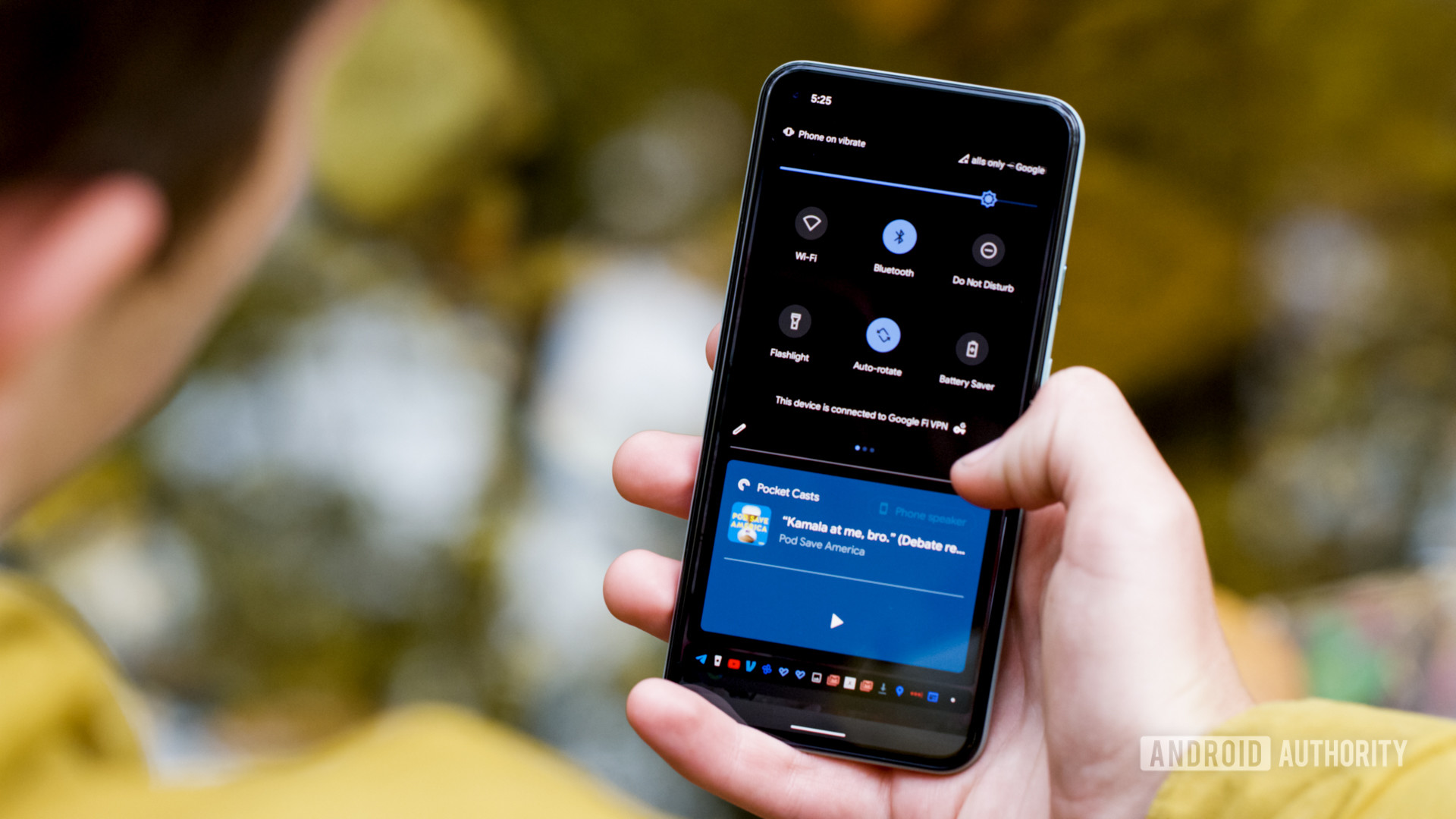
- Android 11 (upgradable to Android 12)
- Pixel Launcher
The Google Pixel 5 ships with Android 11, running Pixel UI on top. This is widely considered one of the best skins on Android due to its tight integration with things like the Google Assistant. Google also, you know, makes Android, so you’d hope its take on the operating system would be good.
Android 11 added features that we previously lamented for not being in Pixel devices. It’s refreshing to finally have things like native screen recording. The new conversation notifications, on the other hand, are a handy way of grouping your important notifications from the non-important ones. Having your smart home controls a power button hold away is super convenient too. This is a legitimately great version of Android, and you can read more about its best features here.
Several software features are exclusive to Pixel devices. Call Screening, Now Playing, and Google Recorder are just a few, and it’s undoubtedly true that you’ll get one of the most intelligent Android experiences on a Google Pixel phone. Almost all of Pixel’s unique features are things you’ll actually use and not gimmicks too. That’s not something that can be said of every smartphone.
Another important part of the Pixel software experience is that Google guarantees software updates and support for at least three years. That means the Google Pixel 5 will definitely receive Android 14, and will likely end up with Android 15 as well. Very few Android smartphones guarantee this much software support.
Google Assistant guide: Make the most of your virtual assistant
Since launch, Google has rolled out regular security updates some major feature drops to the Pixel 5, as well as its other smartphones. The June 2021 update introduced ASTROlaspe to record stars moving across the sky, a Locked Folder feature within Google Photos, and brought features like car crash detection to additional countries.
Google also brought Android 12 and its Material You design language to the Pixel 5 shortly after the Pixel 6 launch. You can read all about the Android 12 features here.
Google Pixel 5 specs
| Google Pixel 5 | |
|---|---|
Display | 6-inch OLED 2,340 x 1,080 resolution 432ppi 90Hz refresh rate 19.5:9 aspect ratio >1,000,000:1 contrast ratio |
Processor | Qualcomm Snapdragon 765G 2x Cortex-A76 6x Cortex-A55 Titan M Security Module |
GPU | Adreno 620 |
RAM | 8GB LPDDR4x |
Storage | 128GB No microSD slot |
Cameras | Rear Main: 12.2MP, f/1.7 aperture, 1.4µm pixels, optical + electronic image stabilization Secondary: 16MP, f/2.2 aperture, 1 micron pixel, ultra-wide (107-degree FoV) 4K at 60fps/30fps Front 8MP sensor, f/2.0 aperture, 1.12µm pixels, fixed focus, 83-degree FoV |
Headphone jack | No |
Battery | 4,080mAh 18W charging 12W wireless charging Reverse wireless charging |
IP rating | IP68 |
Sensors | Proximity / ambient light sensor Accelerometer Gyrometer Magnetometer Pixel Imprint fingerprint sensor Barometer Spectral and flicker sensor |
Software | Android 11 |
Dimensions and weight | 144.7 x 70.4 x 8mm 151g |
Colors | Just Black, Sorta Sage |
Value and competition
At $699, the Pixel 5 easily undercut a lot of 2020 and 2021 flagships on the market, but if you’re looking at devices from a raw specs perspective, it could’ve seemed a bit lackluster. That being said, Pixel phones offer a lot more value than raw performance — from their tight integration with Google apps and services to their fast, guaranteed updates. Pixel devices are also genuinely a pleasure to use, and I think there’s a lot of value in that alone.
Now, the best rival for Google’s Pixel 5 is its own Pixel 6 series. The vanilla model costs just $599, while the premium Pixel 6 Pro is $899. You’ll find the first-generation Tensor chip on both models, and both pack 50MP wide and 12MP ultra-wide lenses as well. The Pixel 6 Pro adds a 48MP telephoto to the mix, and the combination of Gorilla Glass Victus and an IP68 rating means they’re ready for adventure.
With the Pixel 5 no longer in production and the unlocked version of the Pixel 6 retailing for less than the Pxiel 5, there really isn’t a decision to be made here. Buy the Pixel 6. There’s also the Pixel 5a ($449) to consider which carries the same chipset and many of the same specs for less.
If you’re looking for power, you can pay a very similar price for the OnePlus 9 ($729), which sport 65W wired charging and a 120Hz display. It also sports a triple rear camera system, although only the 48MP primary and 50MP ultra-wide are worthwhile (the third camera is a 2MP monochrome lens). The OnePlus 9 also flexes a far more powerful Qualcomm Snapdragon 888 processor and retains wireless charging capabilities (at least outside India), but misses out on an official IP68 rating for the unlocked version.
Another option around this price range is the Samsung Galaxy S20 FE ($699), which has a Qualcomm Snapdragon 865 processor, multiple cameras, microSD expansion, and a 120Hz display for the same price as the Pixel 5. In fact, you can spring for a fully-fledged Samsung Galaxy S21 ($799) for just $100 more.
If you’re a fan of iOS, Apple’s iPhone 13 Mini ($699) also matches the Pixel 5’s price. The iPhone 13 Mini has a much faster processor, but it loses out on refresh rate and the quality of its personal digital assistant.
If you’re someone who needs more power for things like gaming or better video, you might want to look at more specialized options like the ASUS ROG Phone 5 or the Sony Xperia 1 III. That being said, those phones start closer to $1,000 or more, so they’re not really in the same ballpark.
See also: Google Pixel 6 vs Pixel 5 — what’s the difference and should you upgrade?
Google’s phones are also generally smaller than rival Android devices, but those wanting a compact flagship should also consider the ASUS Zenfone 8 ($599). The new flagship packs a 5.9-inch 120Hz display, Snapdragon 888 SoC, dual rear cameras much like the Pixel 5, and a 3.5mm port.
Personally, I think $649 would have been a better price for the Pixel 5. The price difference between the Google Pixel 4a and Google Pixel 4a 5G is $150. Google slapping an extra $200 on the price tag for an aluminum frame, wireless charging, IP68 water and dust resistance, 2GB more RAM, and a 90Hz display seems a bit excessive. Considering the Pixel 4a 5G is effectively a perfectly balanced mix of the Pixel 4a and the Pixel 5, a similar $150 price difference would have seemed more appropriate. The later releases of the Pixel 5a and Pixel 6 just go to show how mismatched the price was here.
Google Pixel 5 review: The verdict
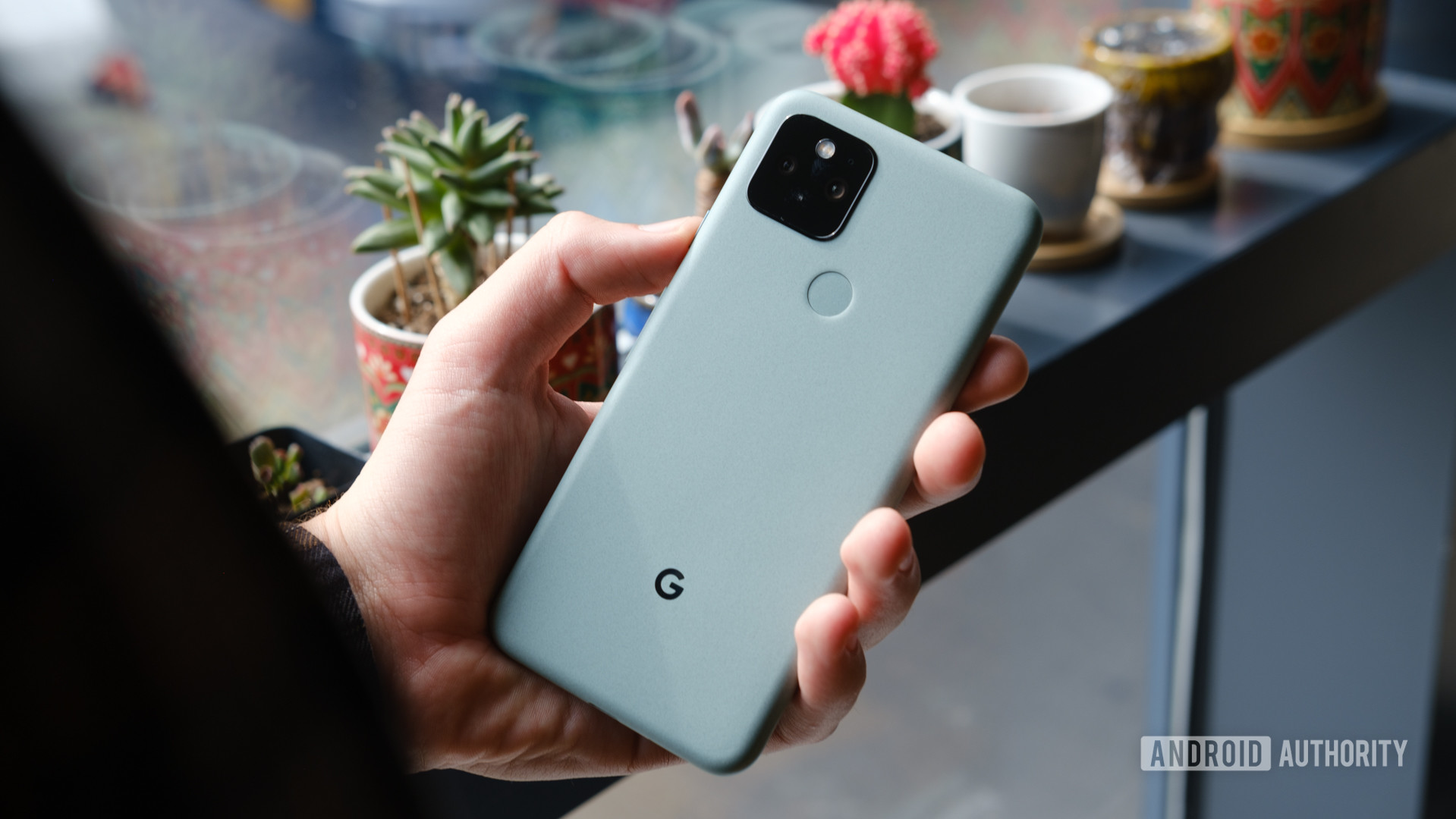
Personally, I’m a huge fan of the Google Pixel 5. It has a genuinely wonderful display, fantastic battery life, and all the small things I love like wireless charging and IP68 water resistance. Additionally, the extremely tight integration with Google’s apps and services, unique features through Google Assistant, and guaranteed updates for three years add a lot more value than a spec sheet can tell.
Another perspective: Google Pixel 5 one year later — Is it still worth buying?
If you were willing to spend $700 and you wanted an Android phone with regular updates, I would’ve definitely recommended the Google Pixel 5. Although 2021 has introduced a few more affordable options that further highlight that the Pixel 5 definitely doesn’t have the fastest processor, the quickest charging, the highest refresh rate display, or the biggest camera sensors. Right now, the choice between picking up a used Pixel 5 or a Pixel 6 (or even Pixel 5a) is a no-brainer — get the latest models.
Even so, the Google Pixel 5 still does the basics better than many other smartphones on the market. The Google Pixel 5 is genuinely a pleasure to use.
That’s been our review of the Google Pixel 5. Are you picking one up? Let us know!